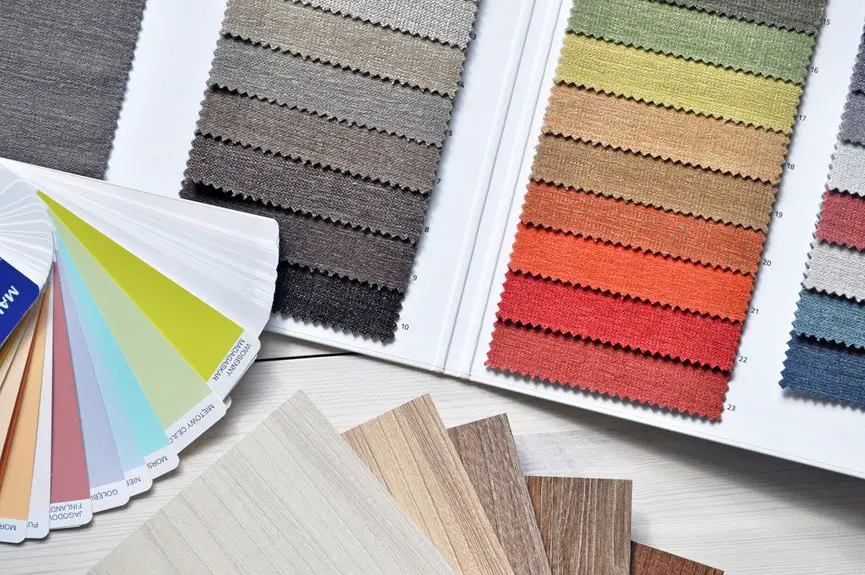Have you ever wondered if there are truly waterproof fabrics that come from nature? It might seem surprising, but the answer isn’t straightforward. Some materials, like wool and treated cotton, have impressive water-repelling qualities. However, the effectiveness and breathability of these fabrics can vary. Exploring the options can reveal intriguing alternatives to synthetic materials that might just change how you think about waterproofing.
Table of Contents
Key Takeaways
- Naturally waterproof fabrics include wool, extra-long-staple cotton, natural rubber, latex, and waxed cotton, providing moisture resistance while remaining breathable.
- Wool repels water and insulates effectively, absorbing moisture without feeling wet, making it ideal for outdoor use.
- Extra-long-staple cotton’s tight fiber structure enhances durability and natural water resistance over time.
- Natural rubber and latex create a flexible, waterproof barrier that is also biodegradable and environmentally friendly.
- Waxed cotton offers durability and a unique aesthetic while maintaining air circulation and water resistance for various applications.
Overview of Naturally Waterproof Fabrics
When you’re looking for protection against the elements, naturally waterproof fabrics can be a game-changer. These materials offer a reliable barrier against moisture while remaining breathable and comfortable.
You might find that materials like cotton, linen, and hemp are treated with natural oils or waxes, enhancing their water-repellent properties. This means you can stay dry without sacrificing style or comfort.
Additionally, naturally waterproof fabrics often come from sustainable sources, making them an eco-friendly choice. They’re perfect for outdoor activities, whether it’s hiking in the rain or enjoying a day at the beach.
Wool: The Natural Water-Resistant Champion
When it comes to natural water resistance, wool stands out thanks to its unique fiber structure.
This structure not only repels water but also provides excellent insulation, making wool a versatile choice for various applications.
You’ll find it in everything from outdoor gear to stylish wearables, proving its adaptability in different environments.
Unique Fiber Structure
Wool stands out as nature’s water-resistant champion, thanks to its unique fiber structure. Each wool fiber is covered with tiny scales that help repel water, creating a natural barrier.
This structure traps air, making the fibers lightweight and allowing them to wick moisture away from your skin. When you wear wool, you’ll notice it stays dry longer, even in damp conditions.
Additionally, the fibers can absorb up to 30% of their weight in moisture without feeling wet, making it ideal for unpredictable weather. The crimp in wool fibers also adds resilience, enabling them to maintain their shape and function effectively.
Natural Insulation Properties
Although many fabrics offer insulation, nothing quite compares to the natural insulating properties of wool. When you wear wool, you’ll appreciate its ability to regulate temperature, keeping you warm in the cold and cool in the heat.
This unique quality stems from the structure of wool fibers, which trap air and create a natural barrier against the elements. Additionally, wool can absorb moisture without feeling wet, keeping you comfortable even in damp conditions.
It’s this blend of warmth and breathability that makes wool a fantastic choice for outdoor activities. You’ll find that it not only insulates your body effectively but also repels water to some extent, making it a reliable option for unpredictable weather.
Versatile Applications and Uses
Wool’s unique water-resistant properties make it a go-to choice for a variety of applications. You’ll find it in outdoor gear, where its ability to repel water while maintaining breathability keeps you comfortable and dry. From jackets to hiking socks, wool’s versatility shines through.
You can also use it for home textiles, such as rugs and upholstery, benefiting from its inherent stain resistance and durability.
In fashion, wool isn’t just functional; it’s stylish too. Think of cozy sweaters and elegant suits that can withstand light rain and moisture. Plus, its natural insulating qualities guarantee you stay warm in cooler weather.
With wool, you’re not just choosing a fabric; you’re opting for a reliable, multi-functional material that meets your diverse needs.
Extra-Long-Staple Cotton: Density and Durability
When you think of extra-long-staple cotton, consider its unique density and durability that contribute to its natural water resistance.
The weaving techniques used can enhance these properties, making it a popular choice in various clothing applications.
Let’s explore how this remarkable fabric stands up against moisture while maintaining comfort and style.
Natural Water Resistance Characteristics
While many fabrics struggle with water resistance, extra-long-staple cotton stands out due to its unique density and durability. This type of cotton isn’t just soft; it also offers natural water resistance characteristics that make it a great option for various applications.
- Tight Fiber Structure: The density of extra-long-staple cotton creates a tighter fiber structure, which helps repel water.
- Enhanced Durability: Its durability means it’s less likely to wear down over time, maintaining its water-resistant properties longer.
- Natural Moisture Management: This cotton efficiently wicks away moisture, keeping you comfortable even in damp conditions.
Weaving Techniques Impact
Understanding how weaving techniques impact the performance of extra-long-staple cotton can greatly enhance its natural water resistance.
By employing tighter weaves, you create denser fabrics that resist water penetration more effectively. The density allows for less space between fibers, making it harder for water to seep through.
Additionally, using advanced weaving methods, like twill or sateen, can increase durability, ensuring your fabric withstands wear and tear while maintaining its waterproof characteristics.
You’ll find that proper finishing techniques also play a significant role, as they can further improve water repellency.
Ultimately, focusing on these weaving techniques won’t only boost the water resistance of extra-long-staple cotton but also enhance its overall performance and longevity in various applications.
Applications in Clothing
The density and durability of extra-long-staple cotton make it an excellent choice for a wide range of clothing applications.
You’ll appreciate how this fabric combines strength with a soft feel, ensuring comfort without sacrificing quality. Whether you’re dressing for work or play, extra-long-staple cotton has you covered.
- Casual Wear: Its breathability and softness make it ideal for everyday shirts and dresses.
- Work Attire: Durable enough to withstand daily wear and tear, it’s perfect for uniforms.
- Activewear: The inherent strength allows for flexibility in workout gear without compromising on comfort.
Incorporating extra-long-staple cotton into your wardrobe means choosing a material that balances functionality with style, making it a smart investment.
Natural Rubber and Latex: Inherent Waterproof Qualities
Natural rubber and latex possess inherent waterproof qualities that make them ideal for various applications, from clothing to outdoor gear. When you choose items made from these materials, you’re opting for durability and protection against moisture.
Natural rubber, harvested from rubber trees, creates a flexible barrier that prevents water from penetrating. Meanwhile, latex, derived from the same source, offers a lightweight yet effective solution for waterproofing. You’ll find these materials in raincoats, boots, and even outdoor furniture covers.
Their natural elasticity allows for comfortable movement, making them perfect for active use. Plus, they’re biodegradable, offering an eco-friendly alternative to synthetic options. By selecting natural rubber and latex, you’re ensuring both functionality and sustainability in your waterproof gear.
Waxed Cotton: Traditional Treatment for Water Resistance
Although modern materials have emerged, waxed cotton remains a classic choice for water resistance. This time-tested fabric combines durability with a unique aesthetic that many people appreciate.
When you choose waxed cotton, you’ll enjoy several benefits:
- Breathability: Unlike synthetic options, waxed cotton allows air circulation, keeping you comfortable.
- Longevity: Properly maintained, waxed cotton can last for years, developing a beautiful patina over time.
- Versatility: You can use it for various applications, from jackets to bags, thanks to its robust nature.
The Role of Nylon in Water Resistance
While waxed cotton has its charm, nylon offers a modern alternative for those seeking water-resistant fabrics. This synthetic material is not only lightweight but also incredibly durable, making it a favorite for outdoor gear and clothing. Its water resistance comes from the tightly woven fibers and the ability to treat it with coatings that repel moisture.
Here’s a quick comparison of nylon’s water-resistant properties:
| Feature | Nylon | Waxed Cotton |
|---|---|---|
| Weight | Lightweight | Heavier |
| Durability | High | Moderate |
| Water Resistance | Excellent | Good |
| Breathability | Moderate | Good |
| Cost | Generally lower | Typically higher |
Nylon’s versatility makes it a compelling choice for modern users.
Comparing Naturally Waterproof Fabrics With Synthetic Options
When choosing between naturally waterproof fabrics and synthetic alternatives, it’s essential to evaluate how each option meets your specific needs.
Both types have their advantages, but understanding their differences can help you make an informed decision.
- Sustainability: Naturally waterproof fabrics often come from renewable sources, making them eco-friendly options.
- Breathability: Natural materials generally allow for better airflow, keeping you comfortable during active use.
- Durability: Synthetic fabrics may offer enhanced durability and resistance to wear and tear, which can be vital for intense activities.
Ultimately, the best choice depends on your priorities, whether it’s environmental impact, comfort, or long-lasting performance.
Applications and Uses of Naturally Waterproof Fabrics
Naturally waterproof fabrics find a variety of applications across different industries, proving their versatility and practicality.
You’ll see these materials in outdoor gear like jackets and tents, where durability and moisture resistance are essential. In the home, they’re used for upholstery and curtains, adding both style and functionality.
Additionally, naturally waterproof fabrics are popular in the fashion industry, where they can create chic, weather-resistant garments. You might also encounter them in sports equipment, such as bags and footwear, designed to withstand the elements.
Beyond clothing, these fabrics serve in industrial applications, providing protective coverings for machinery and equipment.
With their eco-friendly qualities, naturally waterproof fabrics cater to environmentally conscious consumers, making them an excellent choice for sustainable living.
Frequently Asked Questions
Can Naturally Waterproof Fabrics Be Machine Washed?
Yes, you can machine wash naturally waterproof fabrics, but always check the care label first. Use a gentle cycle and mild detergent to maintain their properties, ensuring they stay effective and last longer through washes.
How Long Do the Water-Resistant Properties Last?
Imagine a shield against the rain; the water-resistant properties can last anywhere from a few washes to several years, depending on care and usage. You’ll want to follow care instructions to maximize longevity.
Are There Naturally Waterproof Fabrics for Hot Climates?
You’ll find that while many fabrics can resist water, naturally waterproof options for hot climates are limited. Look for lightweight materials like certain plant fibers that offer breathability and some level of water resistance.
Do Naturally Waterproof Fabrics Require Special Treatment?
You’d think naturally waterproof fabrics wouldn’t need extra care, right? Ironically, they often require special treatments to enhance their performance. So, don’t be surprised if you need a little extra TLC to keep them effective!
Can I Combine Naturally Waterproof Fabrics With Synthetic Ones?
Yes, you can combine naturally waterproof fabrics with synthetic ones. Doing so can enhance durability and performance, but consider how they interact. Test the combination to guarantee they work well together for your specific needs.
- The History and Evolution of Chamois Fabric - June 22, 2025
- Chamois Fabric on Wikipedia: What You Need to Know - June 22, 2025
- How to Pronounce Chamois Fabric Correctly - June 22, 2025






